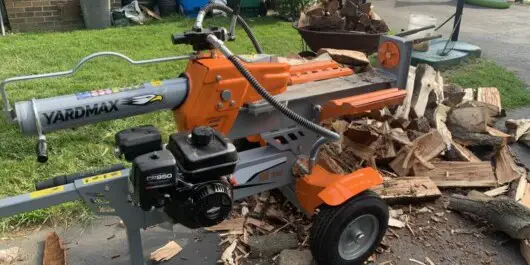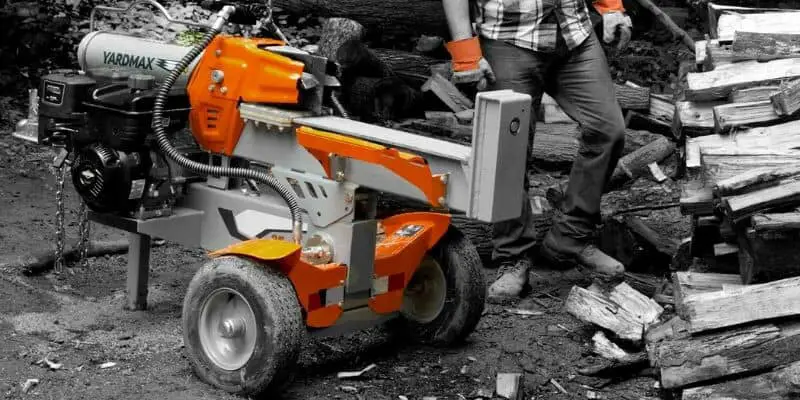Are you a homeowner looking to buy a new half-beam log splitter, but aren’t sure about what a half-beam log splitter is exactly? If so, then this blog is just what you are looking for.
A half-beam log splitter is a log splitter that only supports the front end of the hydraulic cylinder, with the remaining length hanging off the back of the log splitter. The half beam log splitters are also considerably lighter to move around as compared to full beam log splitters. From a performance point of view, there isn’t a significant difference between a full beam and a half beam log splitter. In terms of ergonomics, half beam log splitters are superior to their counterparts.
In this guide, you will get to know all about half beam log splitters, what is a half beam log splitter, what is the difference between a full beam and a half beam log splitter, and more. Continue reading to get all the answers that you’re looking for.
What is a half beam log splitter?
Have you noticed that certain log splitters have full beams, while others have half beams? Why have more and more of these types of log splitters been popping up in the market? If you’re not sure what these beams are, they are the cylinder sticks that stick off the end of the log splitter. These beams are the sticks that the cylinder sticks on.
Traditional log splitters come with full beams to support and stabilize the entire length of the hydraulic cylinder. Meanwhile, the half beam log splitters can only support the front end of the hydraulic cylinder so that the remaining length hangs off the back of the log splitter.
Half-beam log splitters have a shorter table length, although the difference is hardly noticeable. These types of log splitters are more modern, lightweight, and have a great ergonomic design. They are easier to use, while the operating lever for controlling the hydraulic ram is in a better position to provide easier handling. The wheels are fairly close to the machine, making it easier for you to work around the log splitter.
What is the difference between a full beam and a half beam log splitter?
The easiest way of comparing a full beam log splitter to a half beam log splitter is to compare how the two are built. You will then be able to examine the differences and similarities in their structures.
Differences in the construction
The most significant difference between a half beam and a full beam log splitter is the one that gives the two types of log splitters their names. Every log splitter comes with a hydraulic splitter that either drives a wedge into the wooden log or pushes the log against a stationary wedge. The beam to which this cylinder is mounted is shorter on half beam log splitters than it is on a full beam log splitter.
Aside from the size, the mounting position is also very different. On half beam log splitters, the cylinder will come mounted to the center of the beam. On full beam log splitters, the cylinder comes mounted on a connection point near the front or towing end of the machine. Overall, a half beam log splitter is almost 18” shorter than a full beam log splitter. However, the beam isn’t the only part of the structure where users notice the differences.
- Control valve – The control valve will be mounted at the top of a half beam log splitter but is mounted to the side of the full beam log splitter
- Towing components – A half beam logs splitter comes with a shorter tow-bar and a narrower axle compared to their full beam counterparts
- Engine, axle, and wheels – These parts are mounted closer or farther forward to the towing hitch on half beam log splitters than on a full beam log splitter
What are the similarities between half beam and full beam log splitters?
For all the differences, it is important that you should note that half beam and full beam log splitters also have a few similarities. The biggest similarity is in their construction, while they are also capable of providing equal amounts of power.

It is evident in the fact that half beam log splitters and full beam log splitters from the same manufacturer that offer the same amount of tonnage will come with the same key features. Some of those features include engine horsepower, cycle time, and hydraulic pump flow rate. The differences will lie solely in the framework housing these features.
Differences in how the two types of log splitters are used
Manufacturers wouldn’t bother making different styles of log splitters if each one of them didn’t have its own advantages. There are a few things that make half beam and full beam log splitters functionally different.
Ergonomics of the log splitters
Ease of use is among the standout benefits of half beam log splitters. It is very common to hear that half beam log splitters make log splitting much more comfortable.
One of the reasons for this is that there are different layouts of compounds found on half beam log splitters. Because of the top-mounted control valve and a narrower wheel position, many users find that they have to bend over less when using a half beam log splitter. Anyone suffering from sore knees or back pain will know what a lifesaver this can be.
The shape and design of a half beam log splitter will also make the log splitter much easier to use if it is a combination of vertical and horizontal log splitters. The shorter cylinder support beam will be less cumbersome to lift in a vertical position. Once the log splitter is in a vertical position, the top-mounted control handle is in a spot where it’ll be easy to reach and adjust.
Ease of towing the log splitter
One of the benefits of full beam log splitters over half beam log splitters is the stability that the former provides when towed behind a vehicle.
Full beam log splitters have both a wider wheelbase and a longer tow-bar than their half beam counterparts. It makes them less likely to shift or rock when they are being towed along a road.
It must be noted that both of them are safe to tow at low speeds. However, logging and forestry professionals have to travel long distances between job sites, and they cannot depend on traveling just on local roads. Full beam log splitters are great for the stability and dependability needed.
Cost of the log splitters
While the price tag doesn’t necessarily influence how people use their log splitters, it does influence whether they buy a log splitter. Generally, half beam log splitters have a lower price tag compared to full beam log splitters. This is a result of half beam log splitters needing less material in their construction.
As half beam log splitters contain less material, they also weigh less. It makes them not only easier to move, but they are as well less expensive to ship.
Who uses half beam and full beam log splitters?
For homeowners who own a large area and would prefer to save some money on a log splitter that is easy to use, going for a half beam log splitter would be the ideal choice. For the commercial user looking for a dependable log splitter that is easy to transport from one location to the other, a full beam log splitter will be the solution.
However, these guidelines aren’t absolute. Ultimately, you can choose either type of log splitter if it provides the needed splitting force for splitting logs. Half beam and full beam log splitters differ in many ways, but splitting power is certainly not one of them.
FAQs
Are half beam and full beam log splitters different?
From a performance standpoint, there isn’t a huge difference between half beam and full beam log splitters. However, they are different when it comes to design and ergonomics.
How much does a decent log splitter cost?
On average, a log splitter can cost around $1,000. Smaller manual log splitters can cost as little as $70 while mid-range electric log splitters can cost between $350 and $850.
Which is better – half beam or full beam log splitter?
Both half beam and full beam log splitters have their individual benefits and uses. The choice will depend on the needs of the user.


